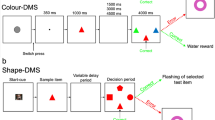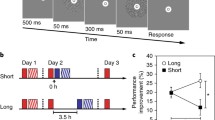Abstract
The effects of modification of NMDA-ergic structures by microdialysis perfusion in the prefrontal cortex (field 8) with NMDA glutamate (2 mM) on visual recognition and short-term memory (STM) were studied in rhesus macaques, using methods based on the deferred differentiation of stimuli of different colors. Impulse activity of neurons in the prefrontal and visual cortex was measured during these experiments, both before and after administration of NMDA. NMDA increased (2-fold) the duration of short-term retention of information and significantly reduced the latent period of the motor response at all delay periods, and also produced significant changes in neuron activity in the prefrontal cortex: depending on the stage of behavior, activity decreased in 60–75% of neurons and increased in 8–26%. NMDA produced significant increases in the cross-correlation coefficients between the responses of neurons in the visual and prefrontal cortex. The results showed that glutaminergic structures in the prefrontal cortex are involved in processes of visual recognition and STM in monkeys. The effect of NMDA, which synchronized cortical neuronal processes, improved the short-term understanding of visual information.
Similar content being viewed by others
References
A. S. Batuev, G. P. Dem'yanenko, A. A. Orlov, and V. I. Shefer, Neuronal Mechanisms in the Conscious Monkey Brain [in Russian], Leningrad (1986).
K. N. Dudkin, Visual Perception and Memory [in Russian], Leningrad (1985).
K. N. Dudkin, V. K. Kruchinin, Yu. V. Skryminskii, and I. V. Chueva, Methods of Automated neuronal Studies: Mechanisms of Behavior [in Russian], Leningrad (1989).
K. N. Dudkin, V. K. Kruchinin, and I. V. Chueva, “Improvements in cognitive characteristics in monkeys elicited by an antioxidant: neurophysiological correlates and the visual cortex,” Fiziol. Zh. I. M. Sechenova,78, No. 12, 78–87 (1992).
K. N. Dudkin, V. K. Kruchinin, and I. V. Chueva, “The effect of an antioxidant on the impulse activity of neurons in the prefrontal and subtemporal cortex in the process of visual recognition in monkeys,” Fiziol. Zh. I. M. Sechenova,79, No. 1, 6–11 (1993).
K. N. Dudkin, V. K. Kruchinin, I. V. Chueva, et al., “A method for cortical microdialysis in studies of the neurophysiological correlates of recognition processes in monkeys,” Fiziol. Zh. I. M. Sechenova,80, No. 10, 128–132 (1994).
K. N. Dudkin, V. K. Kruchinin, and I. V. Chueva, “The effect of modification of glutaminergic structures in the visual cortex on visual recognition processes and short-term memory in monkeys,” Fiziol. Zh. im. I. M. Sechenova, in press (1995).
S. N. Olenev, The Construction of the Brain [in Russian], Leningrad (1987).
M. O. Samoilov, “The role of calcium in mechanisms of cholinergic and glutaminergic signal transduction in the central nervous system,” Zh. Évol. Biokhim. Fiziol.,28, No. 2, 13–27 (1992).
V. M. Storozhuk, S. F. Ivanova, and A. V. Sanzharovskii, “The role of glutamate intracortical connections in conditioned reflex activity,” Neirofiziologiya,24, No 6, 701–712 (1992).
K. N. Dudkin, V. K. Kruchinin, and I. V. Chueva, “Visual recognition in monkeys: effect of modification of glutaminergic structures in the visual and prefrontal cortex,” Perception,22, Suppl. 139 (1993).
E. R. Kandel, “Calcium and the control of synaptic strength by learning,” Nature,293, 697–700 (1981).
M. B. Kennedy, “Regulation of synaptic transmission in the central nervous system: long-term potentiation,” Cell,59, 777–787 (1989).
K. Kubota, T. Iwamoto, and H. Suzuki, “Visuokinetic activities of primate prefrontal unit during delayed response performance,” Neurophysiol.,37, No. 6, 1197–1212 (1974).
G. Lynch, J. Larson, U. Staubli, and R. Grander, “Variants of synaptic potentiation and different types of memory operations in hippocampus and related structurs,” in: Memory: Organization and Locus of Change, L. R. Squire, et al. (eds.), Oxford (1991), pp. 330–363.
C. Lynch and M. Baudry, “The biochemistry of memory: a new and specific hypothesis,” Science,224, No. 4653, 1057–1063 (1984).
K. D. Miller, B. Chapman, and M. P. Stryker, “Visual responses in adult cat visual cortex dependent on N-methyl-D-aspartate receptors,” Proc. Natl. Acad. Sci. USA,86, 5183–5187 (1989).
C. E. Rosenkilde, “Functions of the prefrontal cortex,” Acta Physiol. Scand., Suppl. 514, 1–58 (1983).
STATGRAPHICS user's Guide, Copyright 1987 STSC Inc.
Y. Tsukada, “Molecular approaches to learning and memory,” Jpn. J. Physiol.,38, 115–132 (1988).
T. Tsumoto, K. Hagihara, H. Sato, and I. Hata, “NMDA receptors in the visual cortex of young kittens are more effective than those of adult cats,” Nature,327, 513–514 (1987).
M. Watanabe, “Prefrontal unit activity during delayed conditional discriminations in the monkey,” Brain Res.,225, No. 1, 51–65 (1981).
J. T. Wroblevski and W. Danysz, “Modulation of glutamate receptors: molecular mechanisms and functional implications,” Ann. Rev. Pharmacol. Toxicol.,29, 441–474 (1989).
Additional information
Laboratory for the Regulation of Brain Neuron Function (Director M. O. Samoilov), I. P. Pavlov Institute of Physiology, Russian Academy of Sciences, St. Petersburg. Translated from Fiziologicheskii Zhurnal im. I. M. Sechenova, Vol. 81, No. 1, pp. 32–39, January, 1995.
Rights and permissions
About this article
Cite this article
Dudkin, K.N., Kruchinin, V.K. & Chueva, I.V. Neurophysiological correlates of improvements in cognitive characteristics in monkeys during modification of NMDA-ergic structures of the prefrontal cortex. Neurosci Behav Physiol 26, 545–551 (1996). https://doi.org/10.1007/BF02359497
Received:
Issue Date:
DOI: https://doi.org/10.1007/BF02359497




